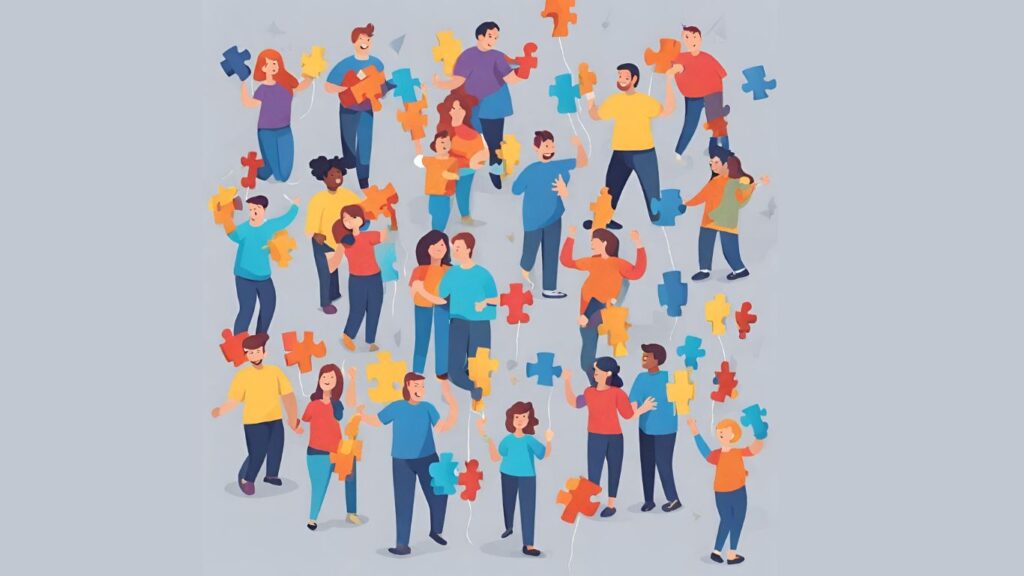There are many myths and misconceptions surrounding ASD. Some of the most common include:
- Myth: Autism is caused by bad parenting or vaccines.
- Reality: There is no evidence to support these claims. The cause of ASD is not yet fully understood, but it is believed to be a combination of genetic and environmental factors.
- Myth: People with ASD lack empathy.
- Reality: People with ASD may have difficulty expressing or understanding emotions, but this does not mean they lack empathy.
- Myth: People with ASD are all the same.
- Reality: ASD is a spectrum disorder, which means that it affects people in different ways and to varying degrees. Each person with ASD is unique and has their strengths and challenges.
It is important to understand that people with ASD are individuals with unique strengths and challenges. By understanding and accepting these differences, we can create a more inclusive and accepting society.
Principles of Autism Acceptance
Autism acceptance is about recognizing and respecting the diversity of human minds and experiences. It is about challenging stigma and stereotypes and promoting inclusion for individuals on the autism spectrum. Here are some key principles of autism acceptance:
Respect for Neurodiversity
The first principle of autism acceptance is respect for neurodiversity. This means recognizing that autism is a natural variation of the human brain and that autistic individuals have unique strengths, abilities, and perspectives that should be valued and celebrated. Rather than trying to cure or fix autism, the focus should be on supporting autistic individuals to thrive and reach their full potential.
Challenging Stigma and Stereotypes
The second principle of autism acceptance is challenging stigma and stereotypes. Autistic individuals often face discrimination, prejudice, and misunderstanding due to negative stereotypes and myths about autism. Autism acceptance involves challenging these stereotypes and promoting accurate, positive, and respectful representations of autism in the media, education, and society.
Promoting Inclusion
The third principle of autism acceptance is promoting inclusion. This means creating environments that are welcoming, accessible, and supportive for autistic individuals. It involves recognizing and accommodating the diverse needs and preferences of autistic individuals, and providing opportunities for them to participate fully in all aspects of society, including education, employment, and social activities.
Effective Communication Strategies
Adapting Communication Styles
When communicating with someone on the autism spectrum, it is important to be aware of their unique communication style. Autistic individuals may have difficulty with nonverbal cues, such as facial expressions and tone of voice. Therefore, it is important to use clear and concise language and avoid sarcasm or metaphorical language. Additionally, it may be helpful to provide visual aids or written instructions to supplement verbal communication.
Furthermore, it is important to be patient and allow the individual time to process information and respond. Interrupting or rushing them may cause anxiety and hinder effective communication. It is also important to avoid making assumptions about their thoughts or feelings, and instead ask clarifying questions to ensure mutual understanding.
Supporting Autistic Voices
When discussing autism acceptance, it is important to center the voices of autistic individuals themselves. This means actively seeking out and listening to the perspectives of autistic individuals, and avoiding tokenism or speaking on their behalf.
One way to support autistic voices is to provide opportunities for self-advocacy, such as allowing them to lead discussions or share their experiences. It is also important to challenge ableist language and attitudes and to promote the idea that autism is a valuable and integral part of human diversity.
Advocacy and Support
Advocacy and support are essential components of promoting autism acceptance. When advocating for individuals with autism, it is important to educate others and create supportive environments.
Educating Others
One of the most effective ways to promote autism acceptance is by educating others. This can be done by sharing personal experiences, providing accurate information, and dispelling myths and stereotypes.
Individuals can educate others by sharing their stories and experiences with autism. This can help to raise awareness and promote understanding. Additionally, individuals can provide accurate information about autism, such as common traits and characteristics, and dispel myths and stereotypes that may be harmful or inaccurate.
Creating Supportive Environments
Creating supportive environments is another important aspect of promoting autism acceptance. This can be done by providing accommodations and resources that meet the needs of individuals with autism.
Supportive environments can be created in a variety of settings, such as schools, workplaces, and communities. For example, schools can provide accommodations such as sensory-friendly classrooms and individualized education plans. Workplaces can provide accommodations such as flexible schedules and job coaching. Communities can provide resources such as support groups and social events.
Resources and Further Learning
Talking about autism acceptance can be a sensitive and complex topic. It is important to gather information and resources to understand the subject better and to be able to talk about it in a respectful and informed manner. Here are some resources that can help:
1. Autism Acceptance Month
April is Autism Acceptance Month. It is a time to celebrate and promote acceptance, understanding, and inclusion of people with autism. The Autism Society of America has a website dedicated to Autism Acceptance Month with resources, events, and ways to get involved.
2. The Autistic Self Advocacy Network
The Autistic Self Advocacy Network (ASAN) is a nonprofit organization run by and for autistic people. They provide resources, advocacy, and support for the autistic community. Their website has a wealth of information on autism acceptance, including articles, videos, and toolkits.
3. Autism Speaks
Autism Speaks is a nonprofit organization that advocates for people with autism and their families. They have a website with resources on autism acceptance, including articles, videos, and toolkits. They also have a “100-Day Kit” for families of newly diagnosed autistic children.
4. Books
There are many books available on autism acceptance and understanding. Some recommended titles include:
- NeuroTribes: The Legacy of Autism and the Future of Neurodiversity” by Steve Silberman
- Uniquely Human: A Different Way of Seeing Autism” by Barry M. Prizant
- The Reason I Jump: The Inner Voice of a Thirteen-Year-Old Boy with Autism” by Naoki Higashida
These resources can provide a starting point for further learning and understanding autism acceptance. It is important to continue to educate oneself and to approach the topic with an open mind and a willingness to listen and learn.







